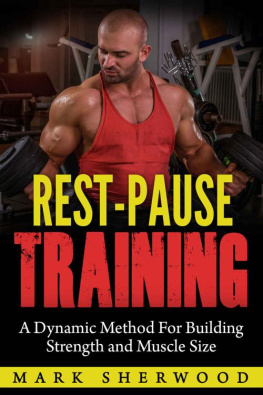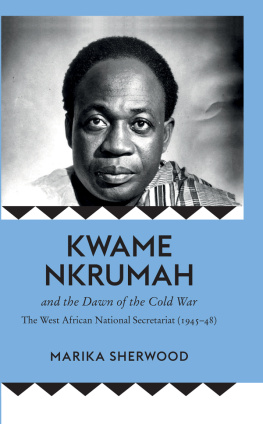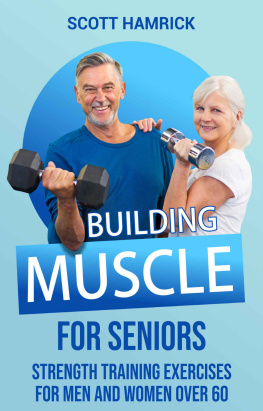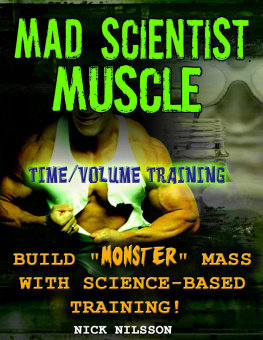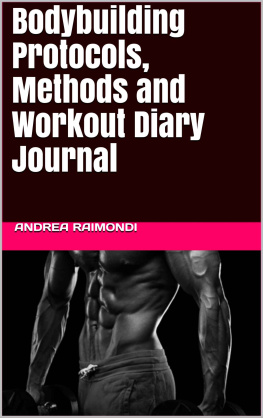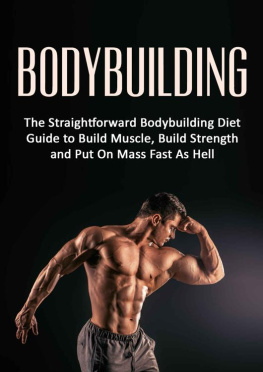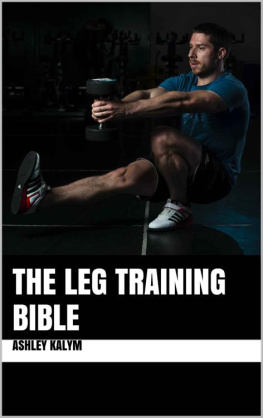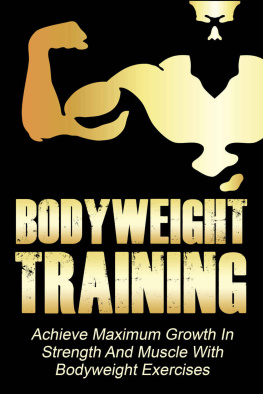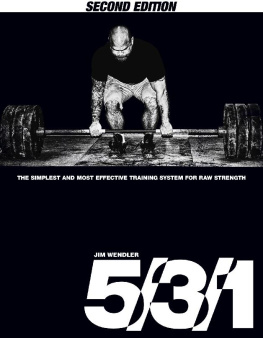I couldnt resist rest-pause training in my early years of weight training. Since I often trained alone, using rest-pause reps seemed like a great alternative to doing forced reps because forced reps required a training partner. In order to get the most out of my set, I would push a set to failure, put the weight down (or rack it), and take a very brief rest. The brief rest allowed me to regain just enough energy to squeeze out one or two more reps. I kept alternating between brief rests and squeezing out one or two reps until I had repeated the process three to four times. After completing a series of rest-pause reps, I would stop and take a longer rest so that I could do a full set again. What I just described is a common form a rest-pause training. Each brief rest is referred to as a rest-pause interval , and each of the reps that is squeezed out between the brief rest intervals is called a rest-pause rep .
Doing rest-pause reps at the end of a set always seemed to give me an excellent pump. The soreness that I would feel the next day was exactly what I wanted to feel because I knew it would lead to added strength and muscle size. As much as I loved rest-pause training, it didnt take long for me to learn that it was something that was excellent for an occasional boost in strength and muscle size, but using it too often could easily lead to burn out.
I have learned a lot since I first began to use rest-pause training, and have discovered ways to adjust it so that it can be used effectively on a frequent basis. While traditional high intensity rest-pause training works best when done occasionally, power based rest-pause training can be done frequently. The biggest difference between the two types of rest-pause training is that power based rest-pause training is modified to limit fatigue while focusing on forceful lifting. Because of the distinction that I make between high intensity rest-pause training, and power based rest-pause training, the book is divided into two sections to address both variations of training. My goal is to provide you with an extensive variety of rest-pause methods that enable you to experience the most productive workouts possible.
Chapter 1
The Most Common Rest-Pause Method

A Full Set Plus Rest Pause Reps at the End
While this book will address a variety of rest-pause methods, the most common rest-pause method has already been addressed in the introduction. You simply start out by doing a set and pushing yourself to do as many reps as you can. This is followed by a brief rest interval of ten to fifteen seconds. After the brief rest, you immediately pick up the weight to do as many reps as you can again. Of course, the brief rest time after completing a full set will not allow you to fully recover your strength, so you will probably only be able to do one to three reps before putting the weight down again. Keep alternating between rest periods of ten to fifteen seconds and doing as many reps as possible until you have done three to four rest-pause intervals after your full set.
Defining a Rest-Pause Interval
When I refer to a rest-pause interval of ten seconds, it doesnt mean to do a rep every ten seconds because it takes time to unrack the weight and get in position to start lifting, and it also takes time to rack the weight or put it down after completing a rest-pause rep. Racking the weight and unracking the weight should not be included when timing the rest-pause interval. When you put your weight back on a rack or set it down, thats when you start timing the rest-pause interval. Once the time interval is completed, you unrack the weight (or pick it up) and begin lifting again.
A typical rest-pause set can be written out in steps as follows:
Do 1 set of 10 reps to failure (or as many reps as possible). Follow this with:
15 seconds of rest
Do 1 to 3 rest-pause reps (do as many reps as possible)
15 seconds of rest
Do 1 to 2 rest-pause reps (do as many reps as possible)
15 seconds of rest
Do 1 rest-pause rep
15 seconds of rest
Do 1 rest-pause rep
Holding the Weight for Rest-Pause Intervals
When doing some exercises such as curls for biceps, or dumbbell lateral raises for shoulders, you may not even want to put the weight down. You can simply hold on to the weights until the rest-pause interval is complete, and start right into another rep. This will be addressed again when discussing various exercises in conjunction with rest-pause training.
Refining Your Rest-Pause Interval
You can refine the rest-pause process by learning exactly how long it takes you to recover to permit just one rep for each rest-pause rep. You may find that it does not even take a full ten seconds of rest in order to recover enough to pick up the weight and squeeze out a single rep. Ideally, the rest-pause intervals between reps should become shorter as you get stronger with a specific weight. For example, if you need fifteen seconds to recover enough strength to do another rep when using 150 pounds, the rest-pause interval should be decreased to twelve seconds, and then ten or less seconds as you gain strength.
Chapter 2
Rest-Pause With Heavy Singles

Max Weight Rest Pause
Rest-Pause reps can be utilized by just doing heavy single reps without doing any consecutive reps beforehand. Powerlifters and Olympic lifters often perform a series of heavy single reps, but they usually rest a few minutes between each single. Rest-pause training with singles is different because the rest intervals are usually only fifteen seconds between single reps. The shorter rests are much more taxing and fatiguing on the muscles and are designed to promote muscle growth instead of just focusing on strength. There have been some bodybuilders who do a max single, followed by a fifteen second rest, and a second max single that probably needs a small amount of assistance from a spotter. Another fifteen second rest is taken followed by a third single that requires more help from a spotter. A fourth and final brief rest is followed by one last rest-pause rep, which will take significant help from a spotter. One of the negative outcomes to this is that by the fourth rep, the spotter is often doing more of the lifting than the lifter.
There are other ways to do rest-pause training with heavy single reps. One way is to do four heavy singles, but not with a maximum weight. In other words, pick a weight that you can do for two or three consecutive reps, but just do it for single reps . After the first rep, do three more single reps with fifteen seconds of rest between each single rep. Ideally, the last rep should be done without help from a spotter, but it should be a very challenging rep.

